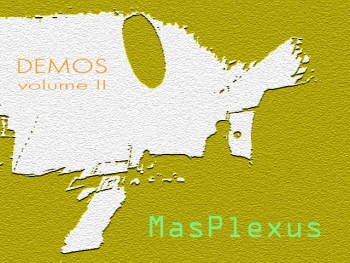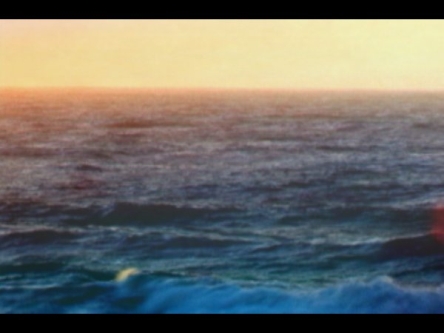Blog - December
If this is your first time reading this blog, it is recommended that you start here.
Please visit http://shiftingshadow.net for my complete collection of music and artwork.
Introduction
In this article, I show the various parallels between the nature of spacetime warpage and certain types of movements in consciousness, hoping to construct a psychological model based on discoveries in and related to Einstein's Theory of Relativity.
The Spacetime Fabric
Einstein's Theory of Relativity showed that space and time were part of one fabric, named spacetime, and that large bodies of mass warp spacetime.
One of the fundamental revolutions in science Einstein created was the way gravity was represented in contrast with the classical Newtonian model. In Newtonian physics, a large mass possessed gravity as a force which pulled other objects towards it. For a relativist, it was the bending of the spacetime fabric around a large mass which produced the effect of gravity on a neighboring object. Thus, planet Earth does not revolve around the Sun because of the pull of the Sun's gravity, it actually follows the equivalent of a straight line in the warped spacetime fabric surrounding the Sun. Scientific observations of Earth's orbit around the Sun have proven Einstein's equations to be accurate in this regard, whereas Newton's classic equations are off to a minor degree.
By solving Einstein's equations, scientists also discovered the existence of black holes, which is essentially an extreme level of warpage surrounding a single "point of singularity". Such a phenomenon could occur if a large body of mass collapsed on itself through its own gravity, or for the reason that "warpage begets warpage", as physicist Kip S. Thorne states in "The Future of Spacetime".
Also according to Einstein's equations, due to the constant speed of light, time slows down as one travels at faster velocities. (This has been verified by placing a highly accurate "atomic clock" on board a very fast jet plane and then comparing the time with another clock that remained stationary on the ground.) In addition, time theoretically slows down as one approaches the center of a black hole.
Constructing a Psychological Theory of Relativity
When I first started reading about black holes and Einstein's relativity theories a few months ago, I began to wonder whether one could construct a psychological model born out of an analogy to the spacetime fabric, let's call it "consciousness-time", and if so, whether or not similar laws would apply between the two.
For instance, when we concentrate on a single idea or visualized image or state of being, are we creating a point of singularity in the consciousness-time fabric? Does the consciousness matrix get warped so that we experience a psychological form of gravity that begins to accelerate us psychologically to the point of our focus?
The Warpage of Subjective Time
Despite being an old book, "A Brief History of Time" by Stephen Hawking still presents one of the best descriptions that I've read on this subject and I highly recommend it as a starter.
Usually, when I read a book, I not only pay attention to what the author is trying to say, but what life is trying to tell me through reading the book's message at that specific moment, in that specific state of mind or passage of my evolution. In a half joking manner, I would claim that I neither judge a book by its cover nor by its contents, but by the synchronicities reading the book produces.
In the case of reading Hawking's book, the synchronistic events were quite interesting. I had taken the train out to a part of the city (San Francisco) with which I wasn't very familiar. I had made this decision because that day, I had a distinct desire bloom within me to take a stroll through a specific neighborhood out there that I had only glimpsed in the past. I did so, and the winding streets left me entirely disoriented as to which direction I should take to head back home. I finally found a bus line that I recognized, but I took it in the wrong direction. By the time I realized I was going the wrong way, I had already traveled a half hour in the opposite direction of my destination!
Throughout the bus ride, I had been reading the section about the Theory of Relativity and the warpage of spacetime. While doing so, I experienced rather distinct fluctuations of my own subjective experience of Time, beginning with the shift from the impatient anticipation of getting home and then surrendering myself to patience and indifference to the length of my trip upon realizing that I had yet another hour on the road because I had been going the wrong way.
When I finally transferred to my usual bus line an hour later, the trip seemed to take the tiniest fraction of the usual time and I felt the world speeding by as if I were on a plane. Such a cluster of synchronistic events highlighted the fact that while the warpage of physical time requires extreme situations such as traveling near the speed of light or nearing the proximity of a large body of mass, warpage of time in consciousness is, relatively speaking, hardly an abnormal event. And in order to establish connections between the laws of spacetime warpage and similar patterns in consciousness, one should recognize the relative ease through which warpage in consciousness can occur. Finally, if there indeed does exist equivalent patterns, then understanding one discipline could provide insight into another, and the fluidity of consciousness can prove to be an aid in our understanding of the physical universe.
Many have claimed experiencing states in which the passage of time became significantly distorted. Although such states have been reported by mystics and near death experiencers, they most commonly occur during a traumatic or pseudo-traumatic event, such as a car crash. My own personal experience occurred when I once dropped a bottle of pepsi on the floor. Time was almost standing still as I watched the bottle spinning in the air in slow-motion, hit the floor and spew out a beautiful, circular fountain of bubbly brown liquid.
One could reason that the intense focus which results from a traumatic situation produces a "point of singularity" in consciousness and enough warpage is created in the consciousness-time matrix to result in a noticeably different experience of Time.
As if in response to these ideas I stumbled across an article on a news website a few days later, which can be found at http://www.livescience.com/health/071211-time-slow.html. It was about a group of scientists that wanted to test whether the subjective effect of the slowing down of time in people due to entering a state of emergency actually enabled them to read a monitor which flickered numbers faster than ordinary consciousness was able to register. The volunteers failed to read these numbers despite clearly feeling the time slowdown effect and the scientists claimed that experiencing the slowing of time comes from an excited portion of the brain registering an extra set of memories, and thus the effect was an illusion.
There are still, however, arguments that question the conclusions of the experiment. For example, perhaps the physical apparatus of vision remains fixed in its speed of receptivity. Consciousness, then, might be experiencing time more slowly but it would be out of sync with the physical process of registering the numbers on the monitor.
Secondly, let us suppose that the sense of emergency propels us into a dream-like state. If so, then just as we have difficulty remembering all the details of our dreams, if any at all, so would our memory be selective during moments of trauma. Had the flickering numbers been instrumental for the volunteers' survival, perhaps the numbers would have been registered accurately.
In any case, from this experiment whether or not consciousness does experience warpage in subjective Time cannot be concluded and while the warpage of time is a curious subject, my own focus is on evolution. And thus, the psychological movement which is interesting is that which ultimately results in higher states of mind. I, therefore, find the study of the malleability of subjective Time to be of limited use and I am more interested to see if we can come up with a model for "psychological gravity" that would help us understand the underlying nature behind the movement of consciousness over time.
Concentration and Meditation
A commonly practiced type of meditation involves establishing a very intense and unwavering concentration on a single point of focus. The ability to accomplish this is seen to be of high importance to Buddhist monks, for example.
Richard Davidson is a scientist famous for his research on emotions and the brain. He collaborated with the Dalai Lama and a team of monks to study brain activity while these experienced practitioners meditated. "What we found is that the longtime practitioners showed brain activation on a scale we have never seen before," said Davidson, the results showed an unusually high level of high-frequency gamma waves and brain synchrony. Click here to read the article in the Washington Post.
The monks were asked to meditate on unconditional compassion. It is a question in my mind whether the same brain activity would have resulted were the monks asked to meditate on something less transcendental in nature. From my experience, unconditional compassion, like unconditional love, like ecstasy, is an energy of a higher order. As I mentioned in the beginning of my October post, such states smooth out one's distortion and enable one to reach higher states of mind, having opened at least the heart chakra, or green ray. My own experience in October allowed me to detect synchronicities quite vividly, i.e. the harmonies in life, and my mind opened up to many new ideas and inter-connections. I experienced a fluidity of thought that was siginficantly different than my ordinary state of mind.
To return to the subject of warped consciousness-time, one way of explaining the process undergone by the monks meditating was that the point of singularity established was unconditional compassion. One can conclude that their concentrative powers enabled the practitioners to quickly arrive at this state, and the resulting brain activity showed significant difference from their normal state, which denotes a profound shift in consciousness.
Long Term Warpage
The monk example leaves one stumbling in the dark because one does not have a solid picture of what the monks were doing exactly. There is the argument, for example, that since unconditional compassion was a state they experienced often, that it took little effort to return to that state through meditation.
Let us proceed to another example. In my August post, I wrote about a fascinating vision I had that told me to "achieve micro-buoyancy". This message, coming from my deeper self I presume, seemed to suggest manifesting both the masculine and the feminine side simultaneously. I did not know what to make of this idea, and so I racked my brain on it for many weeks on end. In other words, it became my point of singularity. The result was a high level of synchronicities, dreams, and traversals in consciousness that were related to the subject of the feminine and masculine polarity. It seemed like life itself was warped to help me explore the subject. After a month or so, I had accumulated a database of events, which, if one were to lay out side by side at once, would look like a slow tornado of experiences that oscillated along the masculine/feminine polarity.
Such an example shows how the movement of consciousness over a long period of time can be affected by retaining a relatively unwavering point of focus. During the Hurricane Period, such exploratory movement occurred completely internally (psychologically), within the span of seconds at times, whenever I focused intently upon a particular subject. The relative increase of the speed of movement was regulated by the intensity with which I focused upon the subject of enquiry. When the Hurricane Thinking occurred smoothly, I would reach revelations concerning my point of focus in a very short amount of time, or rapidly reach a new state of mind that was related to the subject at hand.
Normally, our focus is diffused along the lines of many topics that hold our attention. Unlike when a single aspect of our evolution holds our attention, the resulting underlying order behind our everyday internal and external experiences becomes ambiguous and vague, to be compared to the difference between the ripples made by a single pebble thrown into a pond and the tumultuous ebb and flow when many pebbles are thrown in all at once.
Hallucinating the "X"
Many scientists theorize that at the other side of a black hole is a white hole, that a black hole serves as an entrance into another dimension, or a parallel universe.
One can graph a simple version of the warpage found near a black hole as the bottom half of an "X". And if it is true that white holes exist on the other side, you get a full "X".
In the Ra Material, an "X" is described as a symbol of transformation. It is used in one of the concept complexes that Ra presented as a description of one of the seven archetypes of the mind, namely the "Transformation of the Mind".
As I've stated in earlier posts, I've been hallucinating an "X" almost every time I close my eyes for the last ten years or so. In the beginning, I simply saw the image without any additional innerscape content. Over time, having manifested more curiosity as to its meaning, my visions began explaining this symbol. The first vision showed me that situated at the bottom middle portion of the "X" was the bulk of humanity, and in the top middle portion was depicted a paradise-like setting, complete with a rainbow, an ocean beach, and a palm tree. In other words, the purpose of the game was to go through the middle and into the paradise on the other side.
Over time, I learned that the two poles of the "X" represented the opposite extremes of a polarity. I suspected that it was the masculine/feminine polarity at the time. As one starts nearer the bottom, one's polarization can be quite intense. As one goes up towards the middle of the "X", one is forced to take the middle of the two extremes. At least this was my thinking at the time, which was influenced by popular Buddhist teachings that encouraged taking the middle path. I now see things quite differently, however. And my first explanation why this is not the case is simply that one can easily achieve the middle of the road while still at the bottom of the "X".
What seems to occur is more of a convergence of polarity, or a unification of the opposite poles. In the case of my "achieve mirco-buoyancy" vision, the suggestion was to manifest both sides of the polarity simultaneously. But, how is this is possible? My best answer so far: Through convergence, finding unity, and shedding the extra, unnecessary baggage which either side of a polarity offers.
If one were to take the model of evolution that I've presented in earlier posts to be an upward-spiraling movement that forever diminishes in oscillation (which makes the shape of a cone), the entrance into the next dimension involves the collapsing of the spiral into a single point of singularity.
The Tornado-Like Effects of a Black Hole
Kip S. Thorne, one of the leading theoretical physicists alive today, wrote a chapter in a book titled "The Future of Spacetime" (published in 2002) in which he stated the following:
Besides the bending of space and the slowing and downflow of time, there is a third aspect of a black hole's spacetime warpage: a tornado-like whirl of space and time around and around the hole's horizon [also called the hole's edge].
Now, compare this with a dream I had recently: I was in a room that was filled with boxes and strange furniture. I started climbing the boxes until I reached a height from which it seemed dangerous to come back down. This height represented a higher state of mind and my phobia of returning to a more mundane state. Someone in the dream suggested that I use a very sturdy, newly built ladder, of the latest technology. I started climbing down the ladder but it started oscillating. The lower my state of mind became, the more I orbited round and round.
Kip S. Thorne, in the same article, then states that as one approaches the point of singularity of a black hole, the tornado-like effect turns into an extremely chaotic warpage "on scales so extremely microscopic that they are profoundly influenced by the uncertainty principle [that is witnessed in quantum mechanics]."
Similarly, in my experiences in Hurricane Thinking, there is a shift from a spiraling motion to a seemingly chaotic motion as I approach a higher state of mind. As I wrote in my October post, before ever reading Thorne's words, "The higher the state of mind, the more [Hurricane Thinking] resembles electricity sparking about a neural network."
In my higher states of mind, I have no ego, therefore there is no spiraling motion. What I experience instead is what I call "cosmic thinking". I think a thought, or attentively fixate upon a specific proclivity, and, within nanoseconds or no time at all, I witness reactions to that thought or proclivity. I see them geometrically situated in a pattern similar to the spiraling motion in that I recognize them to be evolution-inspiring. But, I am no longer moving, I think and then witness. It is as if I am interacting with the mind of the cosmos, hence the name.
Converging Polarities
We see in nature that opposites attract, even though they seem incompatible. While "men are from Mars and women are from Venus", the attraction of the opposite sex is ultimately responsible for keeping the human race from going extinct, as is the case with most living creatures. The dynamics between the opposite sides of a polarity may create tension and disharmony, and yet there is an underlying drive towards unity. In the case of the masculine/feminine polarity, this unity is expressed in orgasmic sexual union.
It is only logical to expect that inherent in the makeup of our reality is the impetus to converge the opposite extremes of the various polarities. And as this convergence develops, we reach closer and closer to the middle of the "X".
The Transformation of the Quantum Particle
One of life's greatest and most widely appreciated mysteries is found in Physics, in the microscopic quantum world. There are many aspects of the behaviour of quantum particles which defy logic. I shall concentrate on one of them here, which is named the "wave-particle duality". In short, experiments repeatedly show that a quantum particle can behave both as a wave and as a particle, even though waves and particles have two distinct natures. Some physicists believe that consciousness, in observing or measuring the quanta, "collapses the wave" into a particle, or what is called an "eigonstate". Other physicists have their own theories, which I may visit later.
According to the Seth Material, quantum particles oscillate in and out of our reality, just as some physicists hypothesize that there are parallel worlds and that these particles jump around between them. Where I find the most interest, is that in Hurricane Thinking, the spiral (instead of the wave) collapses and that's when entrance into time-space is made available (which is the upper portion of the "X", or the end result of a transformation). So, perhaps a quanta only properly enters our dimension when the wave collapses into a particle. And, "collapsing the wave" could be an archetypal pattern of transformation, that in order to enter a new dimension a wave must collapse into a particle. In the Ra Material, a being's totality is said to begin to gain "spiritual mass" as it turns to enter the next octave of dimensions.
One can further ideate that the ego, which can be seen as order-creating and hardening energy borrowed from the unconscious, does not actually produce the psychological equivalent of mass in a personality, that mass is only manifested upon crystallization, whose intricate higher order occurs at the microscopic granularity. The ego, in attempting to emulate the hardening of crystallization, solidifies with a weak force at the macro level, but the solidification contains more of the properties of a wave than a particle (Crimson's dragon-ego is made of shards of light and light is a wave). As crystallization of the personality continues, the functions of the ego are required less and less. The personality is compacted and hardens into an ever smaller particle. One slips through the middle of the "X", and transformation occurs.
Transformation Without Compaction
Astronaut X did not reach the moon through a proper compaction of his being. He did so by extreme methods, by what I call "extreme astronautics". Likewise, the Hurricane Period led me to higher states of mind and an overall transformation over time but it was mainly through the extreme astronautics of Hurricane Thinking. In "Human Erasure", Astronaut X "emerged out of a filter of stars, his battered body still sparkling from a celestial upbringing...the filter of stars disseminating him into a new form of infancy...he felt the sting of sparkling needles flash with undeterminate pain; the cry of a dream body."
In my September posting (under the title "A Simple Example of Oscillation"), I wrote of the very loud vision I had of helping others travel through the middle of the "X" through my writing. The vision remained alive within me, and changed over time to show vertical lines spanning both the top and the bottom portions of the "X" as paths of movement. But, the lines did not all go through the middle. I interpret the reason to be that I was filled with a profound sense of unconditional love for humanity at the time.
The Ra Material states that the next higher dimension relative to ours is the dimension of unconditional love. And, the primary requisite for transcending our dimension is to polarize at least 50% in the positive direction, which is also called the Service-to-Others path (as opposed to the Service-to-Self). It would seem logical, then, that the higher order of the energy of unconditional love configures us so that the passage through to the top portions of the "X" is possible. The Ra Material states the prerequisite for the next dimension in another way, as dependent upon the ability of an entity to accept or welcome the next degree of intensity of light.
Jane Roberts and the Seth Material
Jane Roberts was a mystic who channeled in the Seth Material, one of the most popular channeled materials to date. "Seth" was the discarnate entity she allegedly channeled on a regular basis, but she occasionally channeled a higher entity which she named "Seth 2" that seemed to be so far removed from her human self, that it was "devoid of emotion". When channeling Seth 2, she experienced herself going up through a cone or a pyramid. In the words of Robert Butts, her husband:
"I knew that subjectively Jane was experiencing the feeling of a ‘cone’ or ‘pyramid’ coming down over the top of her head. Jane often told me that whereas she feels Seth come to her in a very warm and alive and friendly manner, she feels her consciousness going out of herself to meet Seth 2 ‘up the invisible pyramid like a draft up a flue.’ She doesn’t
know where she goes or how she gets back. Her body seems to be left behind.”
Convergence and Dreams
Our dreams often express a confusing form of convergence, marrying aspects of our reality in a manner which does not make sense to our waking consciousness, although all seems normal while dreaming. Recently, I had such a dream.
In real life, I am a musician and I sometimes create abstract music purely out of sound and noise. In the dream, I was baking noise music (in the oven) and I was using it as a filling in a poptart-like recipe. Combining the noise music with that specific food texture and taste was, in the dream, a complete revelation of the highest import. I even vividly recall the specific fiberous texture of the pop-tart and its relevance to noise music. In addition, this food "pocket" was called "lava".
These concepts are utterly incongruent to my conscious mind. However, the dream seemed entirely reasonable while I was having it; nothing seemed out of the ordinary. I believe that this type of convergence in dreams is a form of psychological compaction that describes the nature of our experience of unity at the middle of the "X". It can also be used to denote the psychological equivalent of the profound forces of gravity at work near the point of singularity of a black hole, where there is a great diminution of matter.
Diminutive Journeys
Most creative people who lead busy lives are familiar with the frustrations of trying to find inspiration when free time finally comes their way. One cannot force oneself to be inspired at will; an inspired state should come naturally. A joyous, care-free, and selfless attitude is usually very helpful in maximizing artistic productivity and balancing this with our inner drive to express our vision is an art in itself.
The movement from an ordinary state of mind to one which is inspired is sometimes itself a magical transformation in consciousness and the analogy of going through the "X" is definately applicable here. As one embarks from the ordinary state of mind, one is usually in a state of expectation and anticipation for the creative outcome. Often, we are either egotistical with our self-confidence in our abilities or caught in a self-destructive state of self-doubt and low self-esteem. Sometimes we osciallate like a wave between the two.
All these aspects of the personality are extra baggage which must be stripped away in order to enter that high "quality of being" (to borrow the term from Carla Reuckert) in which creative work is possible. This stripping away, or diminution, of our selves enables the traversal through the middle of the "X" to the new, inspired state.
Oftentimes, I use various techniques to help me go through such a diminutive journey, such as telling myself repeatedly: "You are a dead man". Or, I would ask myself "What's your story?" and reply: "I have no story. I am a ghost." It is not always necessary for me to reach a completely selfless state before my inspiration kicks in, but if my own conscious thinking and aspiration is incongruent with the intentions of my deeper self, I have to reach rock bottom and surrender myself to a complete sense of giving up in failure before I begin to feel the resilience of inspiration once again.
Once I have been reduced to that infinitesmal minutia of existence, I detect faint glimmers of desire that surface ever so subtly, and these are the intentions of my deeper self speaking through. I then ride them and they typically take me to great places, i.e. the upper portions of the "X".
Such a description of entering an inspired state of mind is a simplistic one. Otherwise, anyone could instantly become creative through a selfless state alone. One factor which is basically missing is that there should be an intent towards a specific, creative aim. Such an aim, when focused upon to the point that it becomes a point of singularity, produces movement in consciousness.
At times, a momentum towards the point of singularity has already been developed but the necessary stripping away of the extra baggage of the personality has not been properly accomplished. This scenario can result in massive psychological dissonance, the equivalent of being ripped apart by a black hole. Many artists have written about such struggles in the past.
Like so many others, I focus upon my creative pursuits on the weekends. When such a short span of time is not enough to find inspiration, my efforts can turn into a crescendo of internal struggle. I have often returned to work on Monday morning practically deranged with psychological pain and confusion, only to return to a state of calm as my focus is diverted towards my job's responsibilities. And ironically, my return to selflessness slingshots me into an exaggeratedly creative state since the original creative point of singularity had as of yet not dissipated. Experiencing this pattern repeatedly, I have acquired habits that help me quickly become detached from the creative pursuits of the day, and thus minimize wasting my free time on the weekends.
Saturday, December 15, 2007
Subscribe to:
Posts (Atom)























